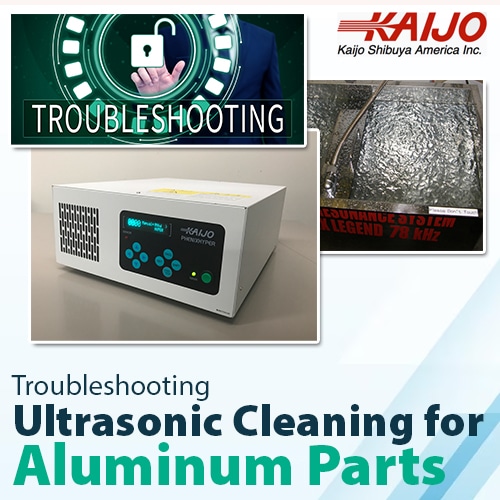Troubleshooting Ultrasonic Cleaning for Aluminum Parts
April 6, 2023
 Ultrasonic cleaning is an effective and efficient method for cleaning aluminum parts and components. However, like any cleaning process, ultrasonic cleaning can encounter issues affecting its performance. This article provides tips and strategies for troubleshooting ultrasonic cleaning for aluminum parts and components, including identifying and resolving common problems to ensure safe and effective cleaning.
Ultrasonic cleaning is an effective and efficient method for cleaning aluminum parts and components. However, like any cleaning process, ultrasonic cleaning can encounter issues affecting its performance. This article provides tips and strategies for troubleshooting ultrasonic cleaning for aluminum parts and components, including identifying and resolving common problems to ensure safe and effective cleaning.
Using the Right Frequency
Ultrasonic cleaning can be a powerful cleaning method, but it can also cause damage to aluminum parts if not used correctly. The use of low-frequency ultrasonic waves can cause pitting or etching on the surface of the aluminum, which can affect the appearance and functionality of the parts. To troubleshoot this issue, you must use the correct frequency and power to clean aluminum without damaging the part. The minimum frequency recommended for cleaning aluminum is 78kHz. Depending on the nature of the surface contamination, frequencies up to 430kHz may be required. If damage has already occurred, it may be necessary to seek assistance from a professional to ensure you are using the right ultrasonic cleaning system for your application.
Insufficient Cleaning Power
Insufficient cleaning power is one of the most common issues that can arise with ultrasonic cleaning of aluminum parts. This can occur if the ultrasonic waves produced by the ultrasonic generator are inadequate for the size of the cleaning tank. While changing the frequency changes the size of the cavitation bubbles that deliver the cleaning action, increasing the power increases the number of bubbles and the intensity of the cleaning process. Insufficient cleaning power can result in incomplete cleaning and leave behind contaminants. To troubleshoot this issue, you must ensure the power settings on the ultrasonic generator are high enough for ultrasonic waves to fill all areas of the cleaning tank. Kaijo’s Quava high-power ultrasonic generator can deliver power up to 1200 watts. High power capacity gives operators the flexibility to adjust both cleaning bubble energy and delivered power to match the requirements of the specific application. If a high-power ultrasonic generator is used with a large cleaning tank, multiple transducers may be needed to ensure ultrasonic waves fill the cleaning tank.
Inadequate Solution Temperature
Another common issue affecting the performance of ultrasonic cleaning for aluminum parts is inadequate solution temperature in the cleaning tank. For certain types of surface contaminants, such as oil and grease, the cleaning solution used in ultrasonic cleaning should be heated to a specific temperature range to maximize cleaning effectiveness. If the solution temperature is too low, the cleaning power of the ultrasonic waves can be reduced and it may take much longer to achieve the required results. To troubleshoot this issue, try using an ultrasonic cleaning tank with a heater to increase the solution temperature.
Contamination of the Cleaning Solution
Contamination of the cleaning solution can also be a common issue affecting the performance of ultrasonic cleaning for aluminum parts. Contaminants such as oils, greases or other substances can accumulate in the solution over time, reducing the cleaning effectiveness of the ultrasonic waves. To troubleshoot this issue, it is essential to regularly monitor and replace the cleaning solution or use a filtration system to remove contaminants from the solution.
Improperly Sized Ultrasonic Tank
The size of the ultrasonic tank can also affect the performance of ultrasonic cleaning for aluminum parts. If the tank is too small for the parts being cleaned, the cleaning effectiveness can be reduced, as the parts must be fully immersed in the cleaning solution to receive adequate exposure to the ultrasonic waves. Conversely, if the tank is too large for the parts being cleaned, there may not be enough power to generate ultrasonic waves to fill the entire tank. To troubleshoot this issue, you may need to upgrade to a larger or smaller tank or seek assistance from an ultrasonic cleaning expert.
Improperly Positioned Parts
The position of the parts in the ultrasonic tank can also affect the cleaning effectiveness of ultrasonic cleaning for aluminum parts. If the parts are not positioned correctly, they may not receive adequate exposure to the ultrasonic waves, resulting in incomplete cleaning. To troubleshoot this issue, ensure that the parts or components being cleaned are not touching the bottom or the sides of the cleaning tank. Use a basket or specialized fixtures to hold the parts correctly during cleaning.
The Bottom Line
Ultrasonic cleaning is a highly effective method for cleaning aluminum parts, but various issues may affect its performance. By following the troubleshooting tips and strategies outlined in this article, you can identify and resolve common problems that may arise using ultrasonic cleaners for aluminum parts and components. Kaijo provides expert guidance to customers to ensure they use the right ultrasonic system to achieve the cleaning requirements needed for their application. Contact Kaijo for a free consultation to discuss which ultrasonic cleaning system and configuration is best for your specific application.





